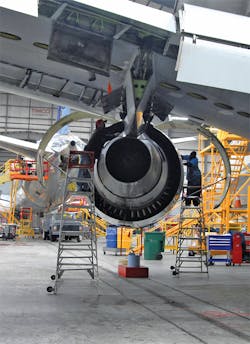A handful of far-reaching trends define heavy maintenance, repair and overhaul today. Even as the MRO industry continues to consolidate, it’s expanding into new markets. At the same time it’s disciplining pricing to boost profits, it’s impelled to improve compensation to attract ever-scarcer technicians. Such are the realities, and the imperatives, of this ever-evolving industry.
Heralded by Hong Kong-headquartered HAECO’s $388.8-million agreement to acquire Greensboro, NC-based TIMCO, we’re witnessing a new breed of merger these days, asserts Christopher Spafford, a partner in the consulting firm Oliver Wyman. “There’s a real difference [between today’s acquisitions] and three to five years ago when the U.S. airframe industry was just teetering on profitability.” Today, healthy companies are merging with similarly robust firms; the resultant mergers are more complementary, designed to fill in gaps in product offerings, not merely expand market share.
Case-in-point: HAECO/TIMCO. The marriage forges the planet’s “second-largest MRO airframe provider, behind ST Aerospace,” calculates Jonathan Berger, vice president of ICF’s MRO Practice. TIMCO is an industry leader in interiors and seats, an increasingly profitable arena in which HAECO wants to grow.
Airline consolidation leads to more interior/seating work
Here too consolidation exerts an inexorable pull, airline consolidation. The American/US Airways and Southwest/AirTran mergers could boost interiors and seating work, as will Delta’s purchase of 88 former AirTran 717-200s. As for the United/Continental combination, United spokeswoman Jennifer Dohm says, “We are not making all the cabins [of its 693 mainline aircraft] uniform, since each subsidiary operated different aircraft types.” UA will, however, be installing Economy Plus seating across the board, as well as fitting its entire mainline fleet with Wi-Fi.
Widebody and narrowbody
Then there’s heavy iron. HAECO maintains, repairs and overhauls 747’s, A330s and the like, while TIMCO specializes in narrowbody A320s and 737NG’s, says Leonard Kazmerski, TIMCO Aviation Services’ vice president for marketing and business development. He contends the merger will enable the combined company (TIMCO keeps its name) to offer more maintenance slot availabilities to customers. Consider, TIMCO has 16 hangars and 33 bays; HAECO 15 hangars and 47 bays.
The two share common customers. TIMCO could benefit from HAECO’s widebody expertise and start accommodating more widebody work in the continental United States. “There are possible synergies we may be able to offer,” says Kazmerski.
Certainly, other players are betting more U.S. carrier widebody work will be repatriated from Asia/Pacific. Chris Spafford asserts over the last of half of this decade maintenance capacity is going to tighten significantly in the region – in China in particular and among widebodies specifically. “Part of that is due to he rapid growth – the hyper-growth – of the domestic Chinese … market.”
Labor rates and U.S. expansion
As Chinese aircraft occupy more bays, Spafford says, that pushes up prices overseas, prompting North American carriers to re-consider the once-powerful Asia/Pacific value proposition. He says 10 to 20 percent of the maintenance performed in Asia/Pacific will migrate back to the continental United States over the next three to five years. “We’re seeing a mild shift” in the repatriation of widebody work.
“Definitely,” agrees Chris Jessup, AAR’s senior vice president of airframe and engineering. “[That’s] one of the main reasons we expanded to our sixth airframe location.” He asserts some hourly touch labor rates in Asia/Pacific are “equivalent, if not higher” than those in North America.
In making the move, AAR takes over 550,000 square feet of space formerly occupied by Aeroframe Services at Chennault International Airport in Lake Charles, LA. An 118,000-square-foot expansion is underway that will allow AAR to accommodate craft as large as the A380.
According to the Baton Rouge-based newspaper The Advocate, AAR will create 500 jobs with an annual average salary of more than $46,000, plus benefits.
Shortage of skilled technicians
It could take at least that level of compensation to combat a persistently troubling trend that threatens to undermine the best-laid plans of MROs and airlines alike: a dearth of talented maintainers. “There really is a shortage of skilled technicians,” says Spafford. Consider natural attrition vs. the number of new technicians entering the industry and the shortfall is “probably …15 to 17 percent,” he asserts. Here’s the kicker: that figure “assumes there’s very little repatriation of widebody work.” He says the crunch is especially acute in the North American market, and will be so “over the next four to five years.”
Labor availability may well be one of the motives behind the HAECO/TIMCO merger. Hong Kong Aircraft Engineering Company is “having issues hiring enough labor,” says ICF’s Berger. That shortage of skilled technicians “drove down [HAECO’s] net profit by 21 percent on year in the first half” of 2013 says the South China Morning Post. The paper quotes Chairman Christopher Pratt as saying HAECO was “seeking government support to import qualified engineers and mechanics to ease constraints on the supply of skilled workers.”
Globally, Boeing’s 2013 Pilot & Technician Outlook forecasts the need for some 556,000 new technicians “to … maintain the new airplanes entering the fleet over the next 20 years.”
Training and recruitment programs
Aeronautical Repair Station Association Executive Vice President Christian Klein released the sobering results of a survey not long ago showing “very few” of its responding members are taking actions needed to lure, train, and retain employees. For example, just 25 percent hire student interns, and a mere 25.8 percent do on-campus recruiting.
An exemplar of how to recruit and keep technicians might just be AAR. “We like to feel we’re … very proactive,” says Chris Jessup. The company has an active apprentice and well as internship program and, “as we recruit technicians we pay [for them to] get additional education.”
South of the border
Other labor pools might lie south of the border. Spafford foresees others taking a cue from Grupo Aeroméxico and Delta and expanding technical opportunities in Latin America – this in the wake of their construction of an MRO center at Querétaro. Delta says it will be able to service seven aircraft simultaneously. In a prepared release, Delta president Ed Bastian says the move to Querétaro from former facilities at Guadalajara International Airport “will usher in lower maintenance costs without compromising the very high quality work that Aeroméxico provides Delta.” Both Delta and Aeroméxico are members of the SkyTeam alliance. Delta purchased a 4.17 percent stake in Grupo Aeroméxico in June 2012.
Spafford expects Querètaro to become something of a template for U.S. carriers, “outside of Aeroman, the first really major, high-quality maintenance facility in Latin America that’s been established in the last five to seven years.”
The Oliver Wyman analyst believes Latin America is rife with technical talent. “Regulatory issues aside, the [region] is primed to be the next area of explosive growth.”
Those issues, of course, center on the U.S. Transportation Security Administration’s issuance of a long-overdue repair station rule. Ten years ago, Congress told TSA to adopt new security regulations. The FAA can’t certify any new foreign repair stations until that happens. The TSA released a final rule on Jan. 13, 2014.
If there’s a single mega-trend imbedded in all this it’s the increasing permeability of international borders to the movement of heavy maintenance. Airlines and MROs are working to further break down those borders, even as they consolidate and seek out new maintainers for the task ahead.
About the Author
Jerome Greer Chandler
Jerome Greer Chandler is a two-time winner in the Aerospace Journalist of the Year competition's Best Maintenance Submission category; he won in 2000 and 2008. He received the Lifetime Achievement Award at the 2017 Aerospace Media Awards in Paris, France. His best-seller 'Fire and Rain' chronicles the wind shear crash of Delta Flight 191 at DFW.

